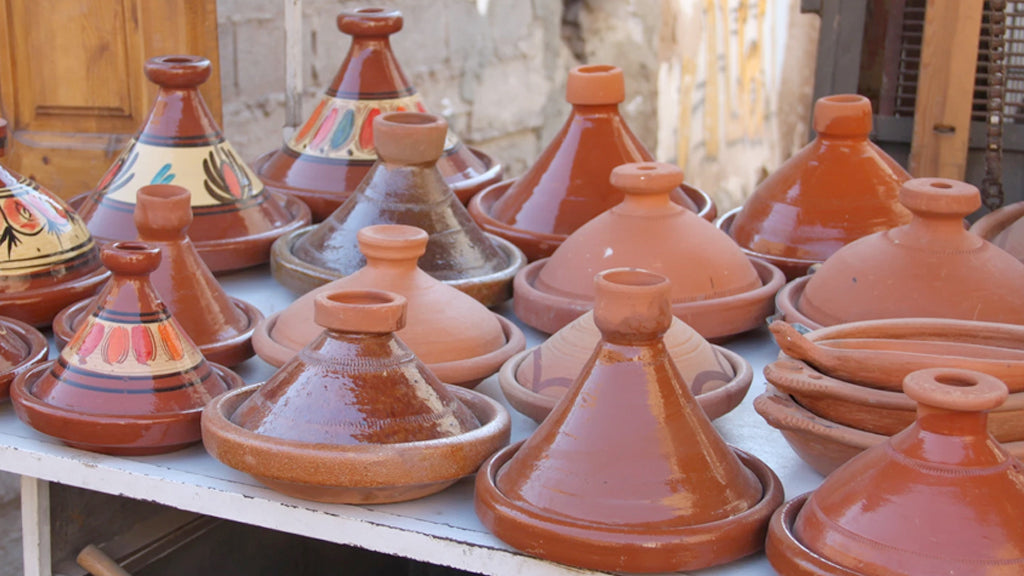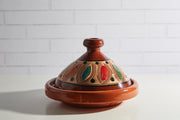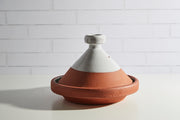 Fired clay pots known as “tagines,” have been used as cooking vessels for millennia, even earning a mention in the ninth century epic story-within-a-story, The Thousand and One Nights. And for good reason! Not only are they excellent heat conductors, which of course make them efficient for cooking, but they also retain both hot and cold temperatures, thereby making them great for transporting the cooked food.
Fired clay pots known as “tagines,” have been used as cooking vessels for millennia, even earning a mention in the ninth century epic story-within-a-story, The Thousand and One Nights. And for good reason! Not only are they excellent heat conductors, which of course make them efficient for cooking, but they also retain both hot and cold temperatures, thereby making them great for transporting the cooked food.
Know the tagine terminology
The term “tagine” refers to both the earthen, cone-shaped, tabletop cooking vessel used to steam dishes and impart flavor, as well as to the final dish that’s made using this device. Verve Culture co-founder Jacquie Lewis, who’s been cooking with a Moroccan cooking tagine for more than 10 years, likens it to a casserole. We cook these hearty meat and veggie creations in a casserole dish and then the resulting meal, no matter what particular ingredients are used, is called a casserole. A more modern-day (and perhaps less Midwestern) interpretation would be a hot pot.
Why tagines have such robust flavor
 You can’t miss the tagine’s distinctive dome-shaped lid. That design is just as functional as it is eye-catching. The lid is designed to trap the steam as the food cooks, bringing it back down the sides of the conical lid into the ingredients, rather than letting the steam escape. The moisture then returns to the food, ensuring your meal is moist and full of flavor. “The moisture is embedded into whatever you’re cooking, so it really intensifies the flavor,” Lewis says.
You can’t miss the tagine’s distinctive dome-shaped lid. That design is just as functional as it is eye-catching. The lid is designed to trap the steam as the food cooks, bringing it back down the sides of the conical lid into the ingredients, rather than letting the steam escape. The moisture then returns to the food, ensuring your meal is moist and full of flavor. “The moisture is embedded into whatever you’re cooking, so it really intensifies the flavor,” Lewis says.
A single cooking method with endless variety
“There are as many recipes with a tagine as you can possibly think of,” Lewis says. “It just depends on what you feel like doing, whether it’s chicken, beef, lamb, or seafood, and what vegetables and spices you feel like in the moment.”
That ability to mix and match nearly any ingredient makes a tagine the perfect gift for someone with a natural knack for creativity in the kitchen. “What’s wonderful about a tagine is you can look up recipes and follow them, or if you’re a cook, you can put together the flavors you really like and make your own dish,” Lewis adds. A couple of her favorite recipes include Stovetop Moroccan Lamb Tagine and Chicken Tagine with Preserved Lemon, Olives, Figs and Almonds.
Most tagine recipes include a delightful yin and yang of sweet and salty flavors achieved by pairing fruits like dried apricots, figs, and prunes to bring out a palate-pleasing sweetness with salty olives, a staple of Moroccan agriculture. You’ll also want to keep some ras el hanout, a mix of 32 spices, on hand, both as a delectable pre-cooking dry marinade and as a flavor-enhancing addition to the tagine.

Home chefs have a range of options for heating their tagine. In Morocco, it’s common to heat the vessel over hot coals. If you don’t have hot coals on hand, however, you can put the tagine in the oven or, as Lewis typically does, put a baking sheet on top of a gas stove burner and set the tagine on top. “This process smooths out the heat distribution to prevent hot spots,” Lewis says.
Don’t forget this one simple step prior to using your tagine for the first time
In the U.S., we’re accustomed to saucepans and casserole dishes that can be used right out of the wrapping paper. That’s not the case, however, with authentic, clay tagines like those offered by Verve Culture. Make sure to soak your new treasure in water for about two hours, transfer it into a warm oven (around 250 degrees), and bake the tagine, slowly increasing the oven’s temperature to around 300 degrees over the course of roughly two hours. This process will cure your tagine, removing the taste of the clay, and ensure it’s functional for years (and countless tasty meals) to come. With time, the flavors you cook with will get imbued into the vessel itself, giving it a richness that’s earned, not bought.
As you use your tagine, don’t worry if a few small cracks appear in the finish. That’s natural given this Moroccan cooking tool is made with clay. It’s still perfectly good to use, but now has more character. Still, avoid shocking the dish with intense heat or sharp temperature changes, e.g., moving it from a hot stove to cold water.
A cooking vessel like no other
Whether you opt for a more traditional-looking tagine with authentic Moroccan stenciling or prefer a slightly more modern, monotone aesthetic, there’s no getting around the fact that these Moroccan cooking vessels make for an eye-catching conversation piece whenever you cook for friends. And that’s even before they’ve had a chance to taste the meal! “They look so beautiful,” Lewis says. “The whole thing about tagine cooking is it looks so lovely, it tastes so delicious, and it’s got some romance about it. It creates a little bit more mystique than just putting a serving platter of food on the table.”
Looking for more authentic Moroccan ceramic? You're sure to love these Moroccan Glazed Bowls with Berber Silver Trim and Beldi Ceramic Cups.



